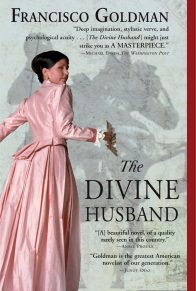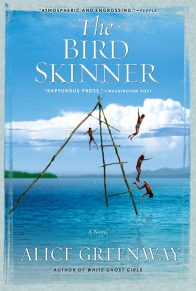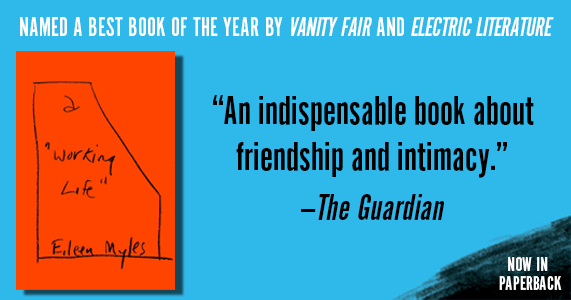I’m starting to get worried. Martes’s face seems to be sort of fluctuating in the light fog induced by my four pints of Guinness. His hand’s resting on the table close to mine. I can see the dark hairs on the back of his hand, his sexy, bony finger-joints and his slightly distended veins. My hand slides toward his and, as if our hands were somehow joined together under the table, his moves away in a flash. Like a crab into its hole.
I look him in the eyes. His face wears a friendly, open, and understanding smile. He seems at once infinitely lovable and completely unknown. His eyes are computer icons, expressionless diagrams, with infinite wonders behind them, but only for the elect, those able to log on.
Martes leans back in his chair. So relaxed. So carefree. “Some good conversation.”
“Nothing more?”
He looks at me as if I’ve exposed something new about myself, something disturbing but paltry: a bit compromising, but not something that will inexorably affect a good working relationship. It’s more as if my deodorant were inadequate.
“I have to tell you honestly that I’m not up for it.”
My heart starts pounding and my tongue responds on reflex, acting faster than my brain.
“It was you who began it.”
When we were little and there was a schoolyard fight, the most important thing was whose fault it was. Who began it.
And as I go on Martes looks at me as if I weren’t responsible for my behavior.
“I’d never have let myself in for this . . . if you hadn’t shown me, so clearly, you were up for it. As I’ve told you, I’m hot shit at avoiding emotional hangups. If I’ve really no good reason to think the other person’s interested I don’t let anything happen. Not a thing. Hell, I don’t even think it.”
Memories are crowding through my mind while I’m sounding off—too angrily, I know. I’m recalling the feel of Martes in my arms, his erection through the cloth of his pants as we leaned on the Tammerkoski River bridge railings that dark night. I can still feel his mouth on mine, tasting of cigarettes and Guinness, his mustache scratching my upper lip, and it makes my head start to reel.
Martes reaches for his cigarettes, takes one, flicks it into his mouth, lights his Zippo and inhales deeply, with deep enjoyment. “I can’t help it if I’m the sort of person people project their own dreams and wishes onto.”
In his opinion nothing has happened.
In his opinion it’s all in my imagination.
I crawl home at midnight, staggering and limping—it’s both the beer and the wound deep inside me. Tipsily, I’m licking my wound like a cat: my thought probes it like a loose tooth, inviting the dull sweet pain over and over again—dreams and wishes that won’t stand the light of day.
The street lamps sway in the wind. As I turn in through the gateway from Pyynikki Square, sleet and crushed lime leaves blow in with me. There’s loud talk in the corner of the yard.
A loathsome bunch of kids are up to something in the corner by the trash cans—young oafs, jeans hanging off their asses and their tattered windbreakers have lifted to show bare skin. They’ve got their backs to me, and one of them’s goading another, using that tone they have when they’re challenging someone to perform some deed of daring. This time it’s to do with something I can’t see, at their feet. Normally I’d give thugs like these a wide berth—they make my flesh crawl. They’re just the sort that make me hunch up my shoulders if I pass them in the street, knowing I can expect some foul-mouthed insult—but just now, because of Martes, because I don’t give a damn about anything and with my blood-alcohol count up, I go up to them.
“This is private property, it belongs to the apartment building. Trespassers will be prosecuted.”
A few heads turn—they sneer—and then their attention goes back to whatever’s at their feet.
“Afraid it’ll bite?” one asks another. “Give it a kick.”
“Didn’t you hear? This is private property. Get the fuck out of here.” My voice rises, my eyes sting with fury. An image from my childhood is flashing through my brain: a gang of bullies from an older class are towering above me, sneering at me, and goading me in that same tone—”Afraid it’ll bite?”—and then they stuff my mouth with gravelly snow.
“Shove it up your ass, sweetie,” one of these juvenile delinquent coos tenderly. He knows I’ve no more power over them than a fly.
“I’ll call the police.”
“I’ve called them already,” says a voice behind me. The ornery old woman who lives on the floor below me and covers her rent by acting as some kind of caretaker has materialized behind me. The thugs shrug their shoulders, twitch their jackets, blow their noses onto the ground with a swagger and dawdle away, as if it was their choice. They shamble off through the gateway, manfully swearing, and the last one flicks his burning cigarette butt at us like a jet-propelled missile. They’ve hardly reached the street before we hear anxious running feet.
The lady snorts. “Well, they did do what they were told.”
“Are the police coming?”
“’Course not. Why bother the police with scum like that? I was off to the Grill House myself.”
The adrenaline’s cleared my head for a moment, but now, as I struggle to dig out my keys, my fingers feel like a bunch of sausages. The woman’s on her way to the gate, and that’s fine, because my pissed brain’s buzzing with a rigid, obsessive curiosity. I wait until she’s off and start peering among the garbage cans.
And there, tucked among the cans, some young person is sleeping on the asphalt. In the dark I can only make out a black shape among the shadows.
I creep closer and reach out my hand. The figure clearly hears me coming. He weakly raises his head from the crouching position for a moment, opens his eyes, and I can finally make out what’s there. It’s the most beautiful thing I’ve ever seen. I know straight away that I want it.
It’s small, slender and it’s curled up in a strange position, as if it were completely without joints. Its head is between its knees, and its full black mane of hair is brushing the muddy pavement.
It can’t be more than a year old. A year and a half at the most. A mere cub. By no means the huge bulk you see in illustrations of the full-grown specimens.
It’s hurt or been abandoned, or else it’s strayed away from the others. How did it get to the courtyard of an apartment building in the middle of the town? Suddenly my heart starts thumping and I swing around, half expecting to see a large black hunched shadow slipping from the garbage cans to the gate and then off into the shelter of the park.
I react instinctively. I crouch down by it and carefully bend one of its forearms behind its back. It stirs but doesn’t struggle. Just in case, I twist the strap of my bag all around the troll so that its paws are fastened tightly to its side. I glance behind me and lift it up in my arms. It’s light, bird-boned, weighing far less than a child the same size. I glance quickly at the windows. There’s nothing but a reddish light glowing in the downstairs neighbor’s bedroom. The glamorous head of a young woman pops up in the window, her hand drawing the curtain. Now.
In a moment we’re in my apartment.
It’s very weak. When I lower it onto the bed it doesn’t struggle at all, just contemplates me with its reddish-orange feline eyes with vertical pupils. The ridge of its nose protrudes rather more than a cat’s, and its nostrils are large and expressive. The mouth is in no way like the split muzzle of a cat or a dog: it’s a narrow, horizontal slit. The whole face is so human-looking—like the face of the American woolly monkey or some other flatfaced primate. It’s easy to understand why these black creatures have always been regarded as some sort of forest people who live in caves and holes, chance mutations of nature, parodies of mankind.
In the light, its cubbishness is even more obvious. Its face and body are soft and round, and it has the endearing ungainliness of all young animals. I examine its front paws: they’re like a rat’s or racoon’s, with flexible, jointed fingers and long nails. I untie it, and the cub makes no move to scratch or bite. It just turns on its side and curls up, drawing its tufted tail between its thighs and folding its front paws against its chest. Its tangled black mane falls over its nose, and it lets out that half-moan/half-sigh of a dog falling asleep.
I stand at the bedside, looking at the troll-cub and taking in a strong smell—not unpleasant, though. It’s like crushed juniper berries with a hint of something else—musk, patchouli? The troll hasn’t moved an inch. Its bony side heaves to the fast pace of its breathing.
Hesitantly I take a woolen blanket from the sofa, stand by the bed a while, and then spread it over the troll. One of its hind legs gives a kick, like a reflex, swift and strong as lightning, and the blanket flies straight over my face. I struggle with it, my heart pumping wildly, for I’m convinced the frightened beast will go for me, scratching and biting. But no. The troll lies there curled up and breathing peacefully. It’s only now that I face the fact that I’ve brought a wild beast into my home.
My head and neck are aching. I’ve been sleeping on the sofa. It’s ridiculously early; still dark. And there’s nothing on the bed. So that’s what it’s all been: a fantasy that won’t survive the first light of day.
Except that the blanket lies crumpled on the floor by the bed, and there’s a faint little sound coming from the bathroom.
I get up and walk slowly, in the light of the streetlamps filtering through the window, creeping as quietly as I can to the bathroom door. In the dusk I can see a small black bony bottom, hind legs, a tufted twitching tail, and I realize what’s happening. It’s drinking from the toilet bowl. The juniper-berry smell is pungent. Then I spot a yellow puddle on my mint-green tiled floor. Naturally.
It has stopped lapping up water and has sensed that I’m there. Its torso is up from the bowl so fast I can’t see the movement. Its face is dripping with water. I’m trying to convince myself that the water is perfectly clean, drinkable. I’m trying to remember when I last scrubbed the bowl. Its eyes are still dull, it doesn’t look healthy, and its pitch-black coat is sadly short of gloss. I move aside from the bathroom door, and it slides past me into the living room, exactly as an animal does when it’s got another route to take—pretending to be unconcerned but vividly alert. It walks on two legs, with a soft and supple lope: not like a human being, slightly bent forwards, its front paws stretched away from its sides—ah, on tiptoe, like a ballet dancer. I follow it and watch it bounce on to my bed, effortlessly, like a cat, as though gravity didn’t exist—then curl up and go back to sleep again.
I go back to the kitchen for a cereal bowl, fill it with water and put it by the bed. Then I start mopping up the bathroom floor, though I’ve got a splitting headache. What the hell do trolls eat?
Back in my study, I leave the door open, boot up my computer, connect to the Internet and type TROLL.
Troll (older forms: hobgoblin, bugbear, ogre), Felipithecus trollius. Family: Cat-apes (Felipithecidae)
A pan-Scandinavian carnivore, found only north of the Baltic and in western Russia. Disappeared completely from Central Europe along with deforestation but, according to folklore and historical sources, still fairly common in medieval times. Not officially discovered, and scientifically classified as a mammal, until 1907. Before then assumed to be a mythical creature of folklore and fairy tale.
Weight of a full-grown male: 50-75 kg. Height standing upright: 170-190 cm. A long-limbed plantigrade, whose movements nevertheless show digitigrade features. Walk: upright on two legs. Four long-nailed toes on the hindlimbs, five on the forelimbs, both including a thumb-like gripping toe. The tail long, with a tuft. The tongue rough. The overall color a deep black, the coat dense, sleek. A thick black mane on the head of the males. Movement only at night. Main nourishment: small game, carrion, birds’ nests, and chicks. Hibernates. Cubs probably conceived in the autumn before hibernation, the female giving birth to one or two cubs in spring or early summer. About the behavior of this animal, however, so extremely shy of human contact, there is very little scientific knowledge. Extremely rare. Supposedly there are about four hundred specimens in Finland. Classified as an endangered species.
Angel
This is making me no wiser. I click on SEARCH and come up with the following.
mammals/carnivores
Because of their great outward resemblance to humans or apes, trolls were originally mistaken for close relatives of the hominids; but further study has demonstrated that the case is one of convergent evolution. Misclassified a primate, the species was first erroneously designated “the Northern Troglodyte Ape” (Latin: Troglodytas Borealis). Later it was observed that the troll belonged to a completely independent family of carnivores, the Felipithecidae, but the apelike attributions survived for a time in the nomenclature, Felipithecus troglodytas. At present, the established, scientifically accepted nomenclature of the species still bows to popular tradition as Felipithecus trollius. An interesting episode in the naming of the troll was a suggestion from the prestigious Societas pro Fauna et Flora: relying on the mythical and demonic connotations, they proposed the name Felipithecus satanus.
Only one other species of the Felipithecidae is known, the almost extinct yellow cat-ape (Felipithecus flavus), a roughly lynx-sized creature whose habitat is the heart of the Indonesian rain forest. The common ancestor of the species is believed, on fossil evidence, to have inhabited Southeast Asia.
Though, on the evidence of its mode of life and dentition, the troll is clearly a carnivore, many scientists consider that the species does not properly belong to the order of Carnivora. Theories exist that the troll is more closely related to the insectivores and primates than to the true feline predators, and this is supported by certain anatomical features.
It has been suggested that several other species whose existence has not been scientifically established beyond doubt (such as the legendary Tibetan “Abominable Snowman,” or Yeti, of hearsay, and the mythical North American Sasquatch, or “Bigfoot”) may also be humanity-shunning representatives of the Felipithecidae family.
Firm proof of the existence of Felipithecus trollius was not obtained until 1907, when the Biological and Botanical Department of the Tsar Alexander University of Helsinki received the carcass of a full-grown troll that had been discovered dead. There had been previous reports of firsthand sightings of trolls, but this legendary creature, oft-mentioned in folk tradition and in the Kalevala, was considered a purely mythical beast in scientific circles. Clearly, the occasional trollcub encountered in the wilderness served to maintain myths of gnomes and goblins, especially in light of the theory that the trolls regulate any great increase in their population by abandoning newborn offspring.
The troll’s ability to merge with the terrain, the inaccessibility of its habitat, its aversion to human contact, its silent night-habits and its hibernation in cave-dens, causing them rarely to leave snow tracks, may partially explain the late discovery of the species. The troll’s zoological history is thus very similar to those of, for example, the okapi, not identified until 1900, the Komodo dragon (1912), and the giant panda (1937). In spite of abundant oral tradition and many sightings by the aboriginal population, accounts of these animals were long classified by scientists as myth and folklore. It is worth remembering that an estimated 14 million subspecies of animals live on the planet, of which only about 1.7 million are recognized and classified, less than 15% of all species. The relatively large cloven-footed animals, Meganuntiacus vuquangensis and Pseudoryx nghetinhensis, for example, were only discovered in 1994 . . .
Angel
As I sit at my computer I glance from time to time at the bedroom. When I was drunk it seemed a hell of a good idea to bring this touching, rejected wild-animal cub into my pad. An animal that may grow as much as two meters tall.
But even now, when I’m totally sober, the animal has something absolutely captivating about it. Is it just a professional’s appreciation of its visual grace?
Or is it that as soon as I see something beautiful I have to possess it? With my camera or with my eye or with my hand?
Through the shutter or by shutting the door? Even though I won’t know what to do with it?
But nothing changes the fact that the creature’s still small. And sick. And weak. And totally abandoned.
I print off a whole load of Internet material, without feeling it’s any help. I return to netzoo and click on EVOLUTION.
I learn that “convergent evolution” refers to species that develop in ways resembling each other without there being any close zoological relationship. Good examples are the shark, the ichthyosaur, and the dolphin, which have developed from completely different vertebrate forms: the shark from fish, the ichthyosaur from land-dwelling reptiles, and the dolphin from land mammals. Nevertheless, they’ve all developed into streamlined, finned and tailed animals in the same ecological group: swift piscivorous marine predators. There are many other examples: grassland-dwelling flightless birds, such as the emu, the ostrich, and the extinct moa; or such semi-aquatic marine creatures as seals, sea-lions, and herbivorous sirenians, notably the dugong and the endangered manatee.
I’m getting more informed than I ever wanted to be. According to the entry, convergent evolution means that, in widely separated terrains, the same atmospheric and environmental conditions can, through their physical properties, produce similar kinds of living organisms from totally different prototypes. Cases of convergent evolution are, on the one hand, the trolls and the Southeast Asian cat-apes, derived from a small arboreal animal slightly resembling the mustelid or racoon, and, on the other, the apes and hominids derived from proto-primate mammals. Both occupied the same ecological niche, where bipedalism and prehensile forefingers were survival factors for the species . . .
Nothing to help me, though.
I look at my computer. It’s just a machine.
I’ll have to try elsewhere.
I can only speculate about the effect of the telephone ringing at Dr. Spiderman’s—at my old flame Jori Hämäläinen’s, that is—”Hämähämä-hämäläinen,” because getting worked up always makes him stammer. Hämähäkki being Finnish for spider, he’s naturally been dubbed “Spiderman.” Eight rings before he replies, and his voice reveals he’s ready to flip his lid.
First I fumble for the customary “How are things?”, etc., but I know that this road will soon be blocked.
‘sweet Angel, golden-haired cherub,” comes Spider’s slightly nasal, taunting voice. “It’s not very long ago you gave me a very nasty kick in the gluteus—after scarcely a couple of months of your angelic blessings. So what, I wonder, makes you call me now? And especially at this early hour.”
I splutter something about how I thought we’d agreed to be friends.
“I was beginning to think your mother had talked some sense into you—she always did dream you’d be partners with a real doctor, didn’t she?” Spider lashes out, making me blush. Then his tone changes, sounding almost interested. “You didn’t manage to net that guy, did you?”
It’s already coming home to me that this call is a terrible mistake, but Spiderman goes on relentlessly.
“There you were, your great blue eyes moist with tears, trying to stammer out that I’m not your type, that I’m not the right one, and how ‘you’d be wounding me if you went on with a relationship where you yourself couldn’t be a hundred percent committed.’ And meanwhile you were going on about that other guy the whole time.”
Was I really? Hell, it was possible. As if I could have possessed him by talking about him, throwing his name about, wouldbe casually.
“You really relished his name on your tongue. Martti, Martti—Martti this and Martti that. Guess how flagrant and repellent it sounded. And it was crystal clear that all your would-be serious, pretty little speech meant was this: you wanted me out of the way, so you could be free to step on the gas when this object of distant adoration—obviously your right-and-proper future commitment—gave the green light. Or what?”
I’m speechless. Incapable of saying anything.
“So then. What do you want?”
I clear my throat. This isn’t going to be easy.
“What do you know about trolls?”
There’s a howl of demonic laughter in my ear. “Angel, darling, now I must have your permission to be inquisitive. Are you writing an essay for school?”
I mumble something stupid about having a bet on it. “You know,” I wind up helplessly, “about the sorts of things they eat.” I can feel the receiver radiating embarrassed silence into Spiderman’s ear.
He finally bursts out, “You ring an expensive veterinary surgeon at eight-thirty on a Sunday morning to ask what trolls eat?”
I know Spider can be a prick and always is, given the chance, but then he’s never been able to resist an opportunity to show off his knowledge either. I’m right. A familiar lecturing tone creeps into his voice.
He starts ticking items off. “Frogs, small mammals. They rob birds’ nests. Sometimes they’ve been reported to prey on lambs in outlying fields, but that’s probably just rumor. There’s a theory that they fish with their paws, like bears, which I’ve no reason to doubt. Hares. Game birds. Now and then a reindeer-calf caught by the leg can end up as a troll’s dinner. Sometimes they harass white-tailed deer, too. They eat carrion when they come across it. A full-grown individual requires a kilo or two of animal protein a day. Any more questions?”
I nod at the receiver and let out assenting noises.
“Definitely carnivores, but not omnivorous like, for instance, bears. Similar digestive system to cats. So if you’re betting that trolls gnaw at spruce shoots by moonlight, your money’s down the drain. And if you want more information, Angel, my fairy queen, go to the library and consult Pulliainen’s The Large Predators of Finland.”
And then, cuttingly, he hangs up.















